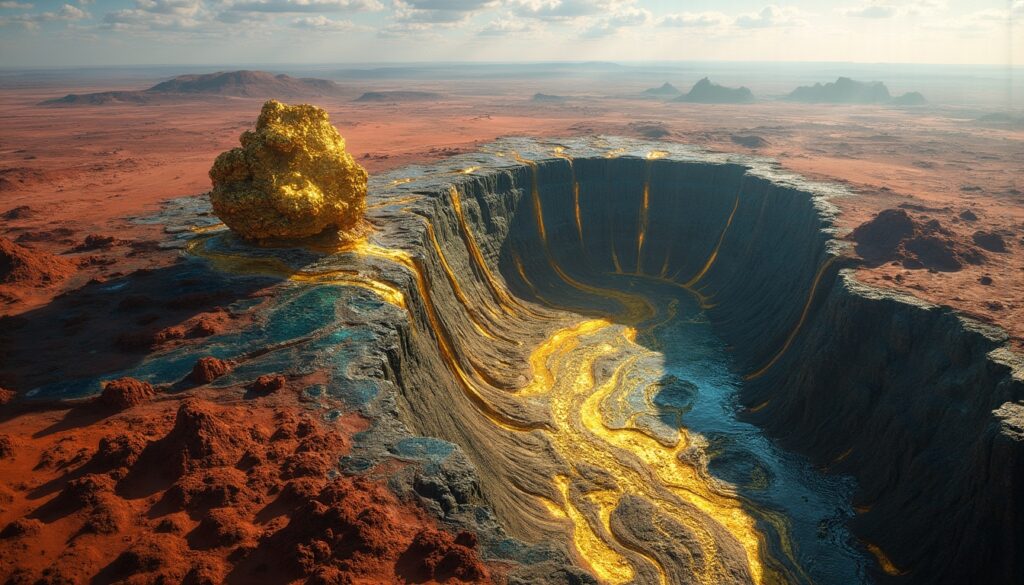How Did the Beater Hunt Mine Form Over 2.7 Billion Years Ago?
The Beater Hunt nickel and gold mine Australia stands as a geological marvel in Australia's mining landscape, with origins dating back to Earth's early development. Located within the ancient Norseman-Wiluna greenstone belt in Western Australia, this deposit began forming during the Archean era nearly 2.7 billion years ago.
During this primordial period, Earth’s interior was far hotter than today. Super-heated komatiite lava flows erupted from deep mantle plumes at temperatures exceeding 1600°C. These flows, with exceptionally high magnesium content, created ultramafic rock formations as they cooled.
The ancient volcanic processes that formed these rocks have parallels with other notable sites, such as ancient planetary rocks. The geologic record preserved at the mine provides clues to Earth’s thermal evolution, which is of great interest to geological research insights.
What Makes the Geology of Beater Hunt So Extraordinary?
Beater Hunt features a rare coexistence of nickel and gold in economically significant quantities. This unusual dual mineralisation has fascinated mining experts over the decades. The deposit resulted from a complex interplay between primary magmatic activity, structural deformation, and later hydrothermal fluid migration.
Nickel sulfide deposits formed during the original komatiite emplacement. As these lava flows cooled, they lost the capacity to hold heavy metals in solution. Nickel, along with copper and iron, crystallised out, concentrating particularly near the base of these flows where they encountered sulphur-rich country rocks. Some similarities can be drawn with carlin gold deposits.
In stark contrast, gold mineralisation occurred later. About 500 million years after the komatiite flows settled, deep hydrothermal fluids began migrating through shear zones and fault systems. These auriferous fluids deposited gold as pressures and temperatures changed, adding an extra dimension of economic potential.
What Was the Father's Day Vein Discovery?
In September 2018, miners at the Beater Hunt nickel and gold mine Australia made a discovery that captivated the global mining industry. While working approximately 500 metres below the surface, they found a spectacular gold-encrusted slab of quartz. This find came to be known as the Father's Day Vein.
The discovery yielded over 24,000 ounces of high-purity gold in just a few days. One highlight was the "King Henry" nugget, a massive 90 kg specimen containing over 2,300 ounces of gold. This spectacular specimen redefined the perceived potential of the mine.
Mining geologists labelled the Father's Day Vein as a bonanza-style deposit, with gold concentrations exceeding 1,000 grams per tonne in some sections. This was orders of magnitude richer than typical commercial grades. The revelation spurred a new exploration focus, developing models to target similar high-grade zones.
How Do Nickel and Gold Form Different Deposits at Beater Hunt?
The dual mineralisation at Beater Hunt represents two distinct geological processes separated by hundreds of millions of years. Nickel sulphides formed during the initial komatiite emplacement roughly 2.7 billion years ago. These ultramafic lava flows erupted at temperatures between 1200°C and 1400°C, dissolving metals like nickel, copper, and iron.
As the hot lava cooled, the dissolved metals crystallised out as minerals such as pentlandite and pyrrhotite. This process was particularly effective near the base of the lava flows, where they incorporated sulphur from surrounding sediments. In many ways, this formation process shares characteristics with those described in epithermal deposit insights.
Gold mineralisation, however, occurred much later through hydrothermal processes. Gold-bearing fluids at temperatures between 200°C and 350°C exploited weaknesses along shear zones and faults. These fluids accumulated within quartz-carbonate veins, particularly in the underlying Lunnon Basalt formation.
Changes in pressure and temperature forced the gold to precipitate out of solution, creating the high-grade zones for which the mine is famous. This dual process enables flexible mining methods that can adapt depending on market conditions.
What Role Did Tectonic Activity Play in Beater Hunt’s Formation?
Tectonic activity was crucial in shaping Beater Hunt into a world-class mineral deposit. The formation of the Norseman-Wiluna greenstone belt resulted from major tectonic forces that compressed and deformed this ancient crust. Initially, the region experienced extensional tectonics which created deep fissures for the komatiite lavas to surface.
Later, the tectonic setting evolved to compressional forces, which resulted in significant crustal shortening. This process generated folding, faulting, and complex stacking of volcanic sequences. The resulting structural architecture was vital for later gold deposition.
Shear zones developed during periods of compression, allowing gold-bearing fluids to accumulate in high concentrations. The tectonic framework at Beater Hunt is similar in complexity to other major deposits discussed in a mining drilling guide.
The interplay of extensional and compressional forces created the ideal conditions for both the nickel and gold deposits. This structural control also contributes to the mine’s long-term economic viability.
How Does Beater Hunt Compare to Other Australian Mineral Deposits?
Beater Hunt stands apart from many other major Australian mineral deposits. Its age and formation processes differ markedly from those of other renowned operations. For example, while Queensland’s Cannington mine formed approximately 1.6 billion years ago with silver, lead, and zinc, Beater Hunt is nearly 2.7 billion years old.
Similarly, the Broken Hill deposit in New South Wales, known for its vast lead-zinc-silver ore, formed around 1.7 billion years ago through sedimentary exhalative processes. Beater Hunt’s komatiite-hosted nickel sulphides, however, were formed through primary magmatic processes.
Meanwhile, Mount Isa’s basin-hosted deposits contrast with Beater Hunt’s structure-controlled, bonanza-grade gold found within fault zones. This rarity makes the mine a true geological time capsule. Many of these comparisons spark discussions in mining investment trends.
What Mining and Exploration Techniques Are Used at Beater Hunt?
Mining operations at Beater Hunt adapt to its dual-commodity nature using sophisticated methods. Underground operations follow both the nickel-rich ultramafic contacts and the gold-bearing shear zones. Decline gradients are carefully engineered, typically around 1:7, to optimise ore transport efficiency.
Exploration teams continue to search for additional bonanza-grade gold. Advanced 3D seismic inversion techniques map shear zones and other structural traps at depth. This data helps geologists develop sophisticated models using insights from mining drilling guide.
Core drilling programmes in challenging ultramafic formations achieve high recovery rates. Specialized drilling fluids ensure that sample quality remains high, even in hard rock conditions. Geochemical assays and pathfinder element analysis further guide the search for undiscovered ore bodies.
The mine’s ability to pivot between nickel and gold extraction is a key economic strength. This operational flexibility ensures that the Beater Hunt nickel and gold mine Australia remains profitable despite market fluctuations.
What Is the Economic Significance of Beater Hunt?
Beater Hunt is not only a geological wonder but also a major economic asset. Originally known mostly for its nickel output, the mine’s economic profile shifted dramatically following the Father’s Day Vein discovery. Before 2018, gold comprised about 20% of revenue, while nickel dominated the economic story.
After the discovery, gold contributions rose to over 60% of revenue. This shift provided greater resilience against market flux. The mine’s dual properties allow operators to target high-margin zones effectively.
Key factors contributing to the economic significance include:
- Low operating costs, with some zones costing as little as $800 per ounce.
- Exceptional profit margins from bonanza-grade specimen gold.
- The potential to uncover further high-grade deposits through ongoing exploration.
The economic ripple effect extends well beyond the mine, supporting local employment and service industries in Western Australia. In turn, this strengthens regional economic stability in times of global market volatility.
What Can Beater Hunt Tell Us About Earth’s Early History?
Beater Hunt functions as a geological time capsule. It preserves evidence of Earth’s early volcanic processes when the planet was in its infancy. The komatiite lavas found here are no longer produced on the modern Earth due to overall cooling over billions of years.
These ultramafic flows, with their high magnesium content, provide crucial insights into early mantle conditions. Researchers use the sulphide layers in the deposit to study ancient atmospheric and oceanic chemistry. Observations like these have encouraged broader discussions in mineral exploration studies.
Additionally, the record of tectonic processes at Beater Hunt illustrates how primitive crustal blocks assembled and deformed. In doing so, the mine reveals dynamic processes that shaped the earliest continents. This research not only educates us about the past but also guides modern mineral exploration strategies.
FAQ: Common Questions About Beater Hunt Mine
What makes komatiite lava different from modern lava?
Komatiites erupted at temperatures over 1600°C with very high magnesium content. Modern lavas, by contrast, rarely exceed 1200°C. These differences highlight the extreme conditions of Earth’s early history.
Why is the Father's Day vein discovery significant?
It revealed ultra-high-grade gold concentrations that defied previous economic models. The find included a 90 kg nugget with exceptional purity. This discovery transformed the mine’s focus and future exploration strategies.
How old is the Beater Hunt deposit?
The host rocks date back roughly 2.7 billion years, marking it as one of the oldest mineral deposits in Australia. Its age offers insights into early crustal formation processes.
Why do nickel and gold occur together at Beater Hunt?
Distinct geological processes, separated by hundreds of millions of years, created this uncommon pairing. Early magmatic events formed the nickel deposits, whereas later hydrothermal activity introduced high-grade gold.
Is Beater Hunt still in operation?
Yes. The Beater Hunt nickel and gold mine Australia continues to produce both metals while exploring for further high-grade zones.
How does gold purity at Beater Hunt compare to other deposits?
Gold from Beater Hunt’s veins typically exceeds 92% purity. This is significantly higher than the average observed in many other deposits, confirming the mine’s economic potential.
Want to Discover the Next Major Mineral Opportunity?
Don't miss out on significant ASX mineral discoveries like those highlighted in this article – Discovery Alert's proprietary Discovery IQ model delivers real-time alerts on potential market-moving announcements, turning complex geological data into actionable investment insights. Explore historic examples of exceptional returns from major discoveries at https://discoveryalert.com.au/news/discoveries/ and position yourself ahead of the market.




